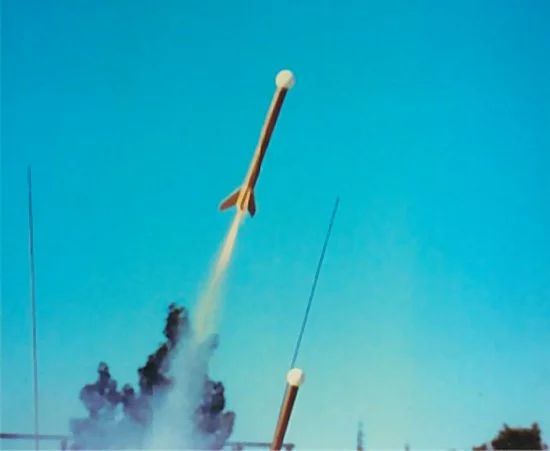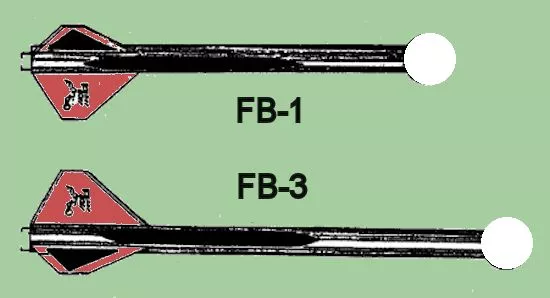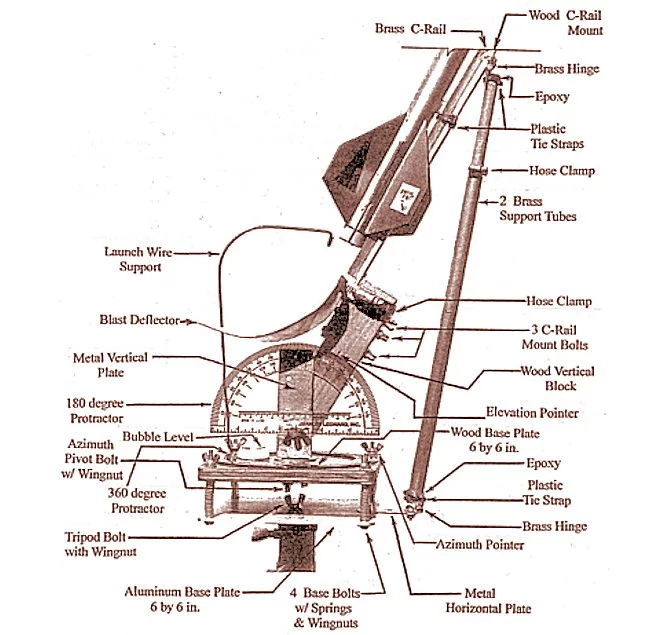"FORE!! Three - Two - One - Fire!" called Doug Frost, inventor of Rocketry Golf and Manager of the Rocketry Golf Organization. Then he launched his ball (on the nosecone of a model rocket) from the tee of the par-five 433-yard first hole at the Ridge Golf Club in Auburn, California. Not fazed by the uphill approach shot to the green, he placed his tee shot...err...launch... only 23 feet from the hole. Unfortunately, Doug isn't much of a regular golfer, and two-putted in for a birdie. Frost's rocketry golf replaces your golf clubs with a selection of rockets and a putter. The rockets are used to launch the ball onto the green, where the traditional putter comes back into play.
The first game of rocketry golf was played in 1989 between Frost (nicknamed "Frog Dust" in rocketry circles) and golf pros Jack Gulo and John Lowe. They played four holes ranging from 157 to 527 yards (144 - 482 m), and Frost managed three over par to beat Lowe and tie Gulo. The first video below shows highlights of this short match.

The rockets and launching system are cleverly designed to provide highly accurate and reproducible drives and chip shots. There are two types of rockets available – roughly speaking, the Fireball-3 (FB-3) is for driving and fairway wood shots, and the Fireball-1 (FB-1) is for long irons through chip shots. (The Fireball-2 is functionally equivalent to the FB-3, save for the engine mount.) Once the ball is on the green, a regular golf ball is substituted and you putt in normally.

The construction materials for both rockets are lightweight and nonmetallic, in accord with the U.S. National Association of Rocketry (NAR) safety rules. The FB-3 takes D or E model rocket engines, having peak thrust of about 25 - 35 Newtons (5.6 - 7.4 lb) and total impulses of 20 and 30 N-sec (4.5 and 6.75 lb-ft/sec).
The FB-3 has a main tube of spiral-wound paper an inch (25.4 mm) in diameter and 17 inches (43 cm) long. There are three basswood fins, which are sanded into airfoils that provide an asymmetric lift to spin the rocket along its axis. This increases accuracy and consistency of the golf course launches. A hollow plastic golf ball with a diameter of 44.5 mm (1.75 in) takes the place of the nose cone. This substitution for a real golf ball both avoids balance problems and launching something that could cause serious injury if a rocket went off course.
The total launch weight of the FB-3 is roughly 100 – 130 g (3.5 – 4.6 oz.), so the peak acceleration of the rocket is in the range of about 30 g's, and the total range varies from about 200 – 600 meters (220 – 660 yds), depending on the thrust curve of the engine, the angle of the launcher, and the delay time before an ejection charge expels a small parachute and a streamer to insure a soft landing. The Rocketry Golf rockets have a piston-type recovery ejection system, which do not scatter paper wadding around the golf course.
The FB-1 is somewhat smaller with a 14 inch main tube, but otherwise has similar construction to the FB-3. The main difference is the engine mount, which is sized to take model rocket engines from 1/2A to C class. These engines have total impulses from 1.25 to 10 N-sec (0.3 – 2.25 lb-ft/sec) and peak thrust in the range of 8 to 15 N (1.8 – 3.4 lb). The launch weight for the FB-1 is perhaps one to one and a half ounces (28 – 42 g) smaller than the FB-3, but this doesn't quite make up for the smaller thrust. Peak accelerations for the FB-1 are in the range of 10 – 20 g's. Still, depending on the engine size, the launch angle, and the ejection delay, the FB-1 can be used for shots from 350 yards (320 m) to 4 yards (3.6 m).

Aside from the accurate and reliable design of the rockets, playing a good game of Rocketry Golf depends on having a solid and easily adjustable launcher. While there are many possible solutions to this requirement, RocketryGolf.com (Frost's company) makes available a precision launcher that mounts to a camera tripod for portability. He claims it is adjustable to half a degree accuracy in both elevation and azimuth.
An 18-hole round of Rocketry Golf would be a costly venture. If two rocket shots are needed on average to reach the green, 36 rocket engines would be needed for the round. The bulk price for the smaller engines is about US$3 each, which isn't too bad. However, the E engines required for teeing off on the par-five holes cost $18 each. I make it $150 – 200 for a round – not counting the green fees, of course.
There is one outstanding safety issue in Rocketry Golf. To have the flexibility in range that is required for a round of RG, it is necessary at times to orient the launcher at rather low angles. This is against the model rocket safety code, which requires that no model rocket be launched at an angle more than 30 degrees from the vertical. Frost has applied for a waiver of this requirement, but has not yet heard if it has been granted.
NAR membership comes with special two million dollar liability insurance for model rocket activities. This is important, as no conventional insurance policy will cover such claims. However, the insurance does not cover model rocket activities, such as Rocketry Golf, that violate the NAR safety code. The NAR's decision will determine if Rocketry Golf becomes a mainstream rocket game, or if it will only survive as a rogue activity.
Before we leave rocket golf, one more attempt at melding rockets and golf has come to my attention. This is the saga of the Rocket Driver, designed and built by T2 Design, which is a conventional driver fitted out with an engine mount for a B6-0 model rocket engine and some means for igniting the engine at the top of the swing. Then, as shown in the lead photo, the golfer's swing is made more powerful by the thrust of the rocket engine.
The test in the second video below is the only one made, and it was cut short by the entrance of the Fire Department, who had been called by the course's golf pro. A distance for the drive was not measured, as the shot was sent into the rough. T2 also developed a second club having mounts for two B6-0 engines, but that one has never been tested.
As a golfer, even though a duffer, I am a bit suspicious of the utility of the Rocket Driver. I don't believe that a couple of pounds of thrust would add much distance, given that the momentum of one's whole body is used in a proper swing. Still, as there is no rational extension of the NAR rules (or even U.S. Federal law) under which use of the Rocket Driver would be legal, it will stay at the rogue fringes of both activities. Fun to watch, though.
Sources: RocketryGolf.com and YouTube




